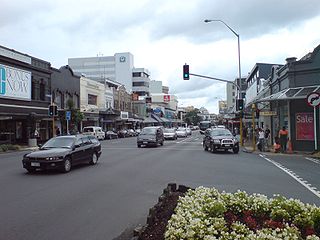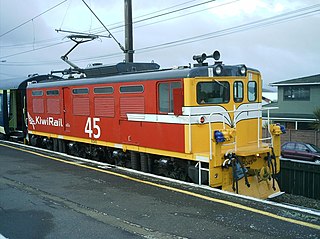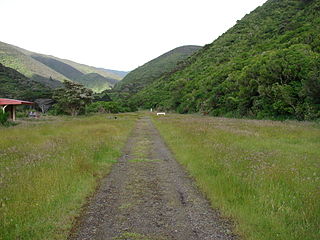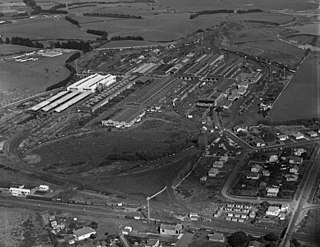
Newmarket is an Auckland suburb to the south-east of the central business district. With its high building density, especially of retail shops, it is considered New Zealand's premier retailing area, and a rival of local competitor Auckland CBD.

Westfield railway station was a station of the Auckland railway network in New Zealand. The station closed to all services on 12 March 2017, following an announcement by Auckland Transport on 17 January 2017, because fewer than 330 passengers used it daily and it required a costly upgrade.

Newmarket railway station is a station in the inner-city suburb of Newmarket in Auckland, New Zealand. It serves the Southern, Onehunga and Western Lines of the Auckland railway network, and is the second-busiest station in Auckland, after Britomart.

Ōtāhuhu railway station is located on the Eastern and Southern Lines of the Auckland rail network in New Zealand. It has an island platform configuration and is part of an integrated bus-train major transport hub. It can be reached by steps and lift from an overhead concourse that leads from the adjacent bus transfer station and Walmsley Road.

Hillside Engineering Group is a trading division of the rail operator KiwiRail in Dunedin, New Zealand. Most of its work is related to KiwiRail, but it also does work for the marine industry in Dunedin. On 19 April 2012 KiwiRail announced it was putting Hillside on the market for sale. In November 2012 KiwiRail announced it had sold part of the business to Australian firm Bradken, and the rest would be closed. The workshops continued to be used for some maintenance work by Kiwirail with a skeleton staff. In October 2019, the New Zealand Government announced that it would be investing NZ$20 million into revitalising Hillside Engineering as a major mechanical hub and engineering facility to service Kiwi Rail's locomotives and rollingstock.
The New Zealand Railways Department, NZR or NZGR and often known as the "Railways", was a government department charged with owning and maintaining New Zealand's railway infrastructure and operating the railway system. The Department was created in 1880 and was corporatised on 1 April 1982 into the New Zealand Railways Corporation. Originally, railway construction and operation took place under the auspices of the former provincial governments and some private railways, before all of the provincial operations came under the central Public Works Department. The role of operating the rail network was subsequently separated from that of the network's construction. From 1895 to 1993 there was a responsible Minister, the Minister of Railways. He was often also the Minister of Public Works.

The Glenbrook Vintage Railway (GVR) is a heritage steam railway in Glenbrook, New Zealand.
This is a list of jargon commonly used by railfans and railway employees in New Zealand.

The New Zealand DA class locomotive were a class of diesel-electric mainline locomotives operated on the New Zealand railway system between 1955 and 1989. Consisting of 146 locomotives, it was the most numerous class to ever operate in New Zealand, with five more than the AB class steam locomotive.

The NZR WF class were steam locomotives designed, built and used by New Zealand Railways (NZR). Their wheel arrangement is described by the Whyte notation 2-6-4T and the first members of the class entered service in 1904. The locomotives were tank engines designed by the Railways Department's Chief Mechanical Engineer A. L. Beattie, and were mainly built for suburban duties such as those between Christchurch and Lyttelton. They also saw main-line service in the Taranaki region, but most of the class members were assigned to branch line and local services throughout the country. Two were experimentally converted to oil burners in 1909-1910. The tests were satisfactory, but as coal was much cheaper than oil at the time, no further conversions took place.

The New Zealand DSC class locomotive is a heavy shunting locomotive used throughout New Zealand. The class was built in seven batches, the first 18 locomotives being built by British Thomson-Houston of the United Kingdom, with the remainder being built by New Zealand Railways (NZR).

The New Zealand EA class of electric locomotives were used on the New Zealand rail network between 1968 and 1997 on the Otira – Arthur's Pass section of the Midland line in the South Island, through the Otira Tunnel. Following reconditioning, three were used by KiwiRail's Tranz Metro in Wellington from 2008 to 2011 to top and tail Metlink suburban passenger trains as an interim measure before new rolling stock arrived. Four of the five locomotives were scrapped in 2013 with one being set aside for preservation.

Cross Creek railway station was the base of operations for the Rimutaka Incline, a Fell railway over the Remutaka Ranges, and part of the original Wairarapa Line between Upper Hutt and Featherston in the Wellington region of New Zealand's North Island. The station was between Pigeon Bush and Summit stations on the Wairarapa Line. The station was bypassed when the Rimutaka Tunnel was opened.
The East Town Railway Workshops were a major manufacturing, maintenance and repair facility of the New Zealand Railways Department (NZR) located by the Marton - New Plymouth Line in the city of Wanganui in New Zealand's North Island. Output included not only rolling stock but also tools, equipment, huts, furniture and tarpaulins. It was a prodigious facility, and one of the larger employers in the city. Its name is sometimes formatted as Eastown or Easttown.
The Petone Workshops were a government-owned railways maintenance and repair facility located in Petone, in Lower Hutt in the Wellington region of New Zealand's North Island. It took over construction and maintenance of rolling stock in the Wellington region from the Pipitea Point facility, starting in 1876, and became the only such facility in the region from 1878 until the opening of the replacement Hutt Workshops facility in 1929.

Christchurch railway station is in the Canterbury region of New Zealand's South Island. It is on the Main North Line at Addington junction, and is the only remaining passenger railway station in the city: suburban passenger trains were cancelled due to lack of demand in the 1970s. It is the terminus of the South Island's two remaining long-distance passenger trains, the Coastal Pacific to Picton and the TranzAlpine to Greymouth.

Railway workshops are railway facilities in which rolling stock is repaired. While often colocated with engine sheds to perform routine tasks as well as major repairs, in some countries separated concepts exist with railway workshops being specialized in major repairs and general inspections.
The NZR 50-foot carriage of 1908 were originally constructed for the North Island Main Trunk (NIMT) passenger trains. The first were clad in Kauri, with open end platforms, however those built from 1930 were clad in steel, with enclosed vestibules. These main line cars were used by the NZR.















